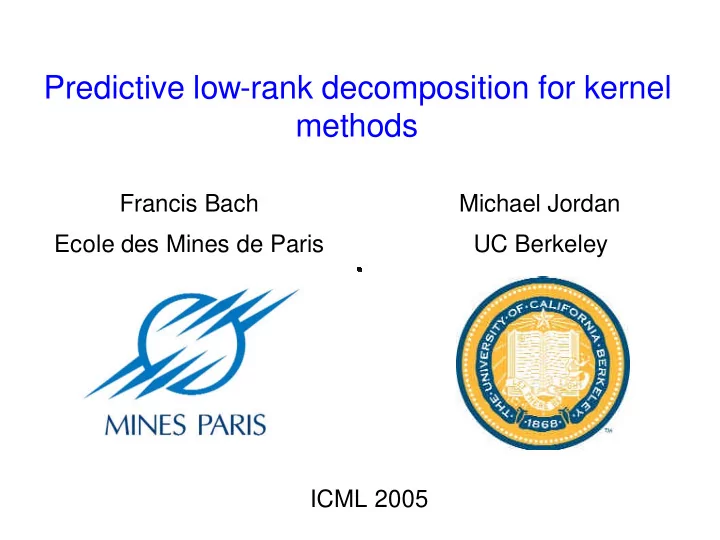

Predictive low-rank decomposition for kernel methods Francis Bach Michael Jordan Ecole des Mines de Paris UC Berkeley ICML 2005
Predictive low-rank decomposition for kernel methods • Kernel algorithms and low-rank decompositions • Incomplete Cholesky decomposition • Cholesky with side information • Simulations – code online
Kernel matrices • Given – data points – kernel function • Kernel methods works with kernel matrix – defined as a Gram matrix : – symmetric : – positive semi-definite :
Kernel algorithms • Kernel algorithms, usually or worse – Eigenvalues: Kernel PCA, CCA, FDA – Matrix inversion: LS-SVM – Convex optimization problems: SOCP, QP, SDP • Requires speed-up techniques for medium/large scale problems • General purpose matrix decomposition algorithms: – Linear in (not even touching all entries!) • Nyström method (Williams & Seeger, 2000) • Sparse greedy approximations (Smola & Schölkopf, 2000) • Incomplete Cholesky decomposition (Fine & Scheinberg, 2001)
Incomplete Cholesky decomposition – is the rank of – Most algorithms become
Kernel matrices and ranks • Kernel matrices may have full rank, i.e., … • … but eigenvalues decay (at least) exponentially fast for a wide variety of kernels (Williams & Seeger, 2000, Bach & Jordan, 2002) Good approximation by low rank matrices with small • “Data live near a low-dimensional subspace in feature space” • In practise, very small
Incomplete Cholesky decomposition • Approximate full matrix from selected columns: ( use datapoints in to approximate all of them) • Use diagonal to characterize behavior of the unknown block
Lemma • Given a positive matrix and subsets • There exists a unique matrix such that – is symmetric – The column space of is spanned by – agrees with on columns in
Incomplete Cholesky decomposition • Two main issues: ? ? – Selection of columns ( pivots ) – Computation of • Incomplete Cholesky decomposition – Efficient update of with linear cost – Pivoting: greedy choice of pivot with linear cost
Incomplete Cholesky decomposition (no pivoting) k=1 k=2 k=3
Pivot selection • approximation after k-th iteration • Error • Gain after between iterations k-1 and k = • Exact computation is • Lower bound
Incomplete Cholesky decomposition with pivoting Pivot Pivot selection permutation k=1 k=2 k=3
Incomplete Cholesky decomposition: what’s missing? • Complexity after steps: • What’s wrong with incomplete Cholesky (and other decomposition algorithms)? – They don’t take into account the classification labels or regression variables – cf. PCA vs. LDA
Incomplete Cholesky decomposition: what’s missing? • Two questions: – Can we exploit side information to lower the needed rank of the approximation? – Can we do it in linear time in ?
Using side information (classification labels, regression variables) • Given – kernel matrix – side information • Multiple regression with d response variables • Classification with d classes – if n-th data point belongs to class i – 0 otherwise • Use to select pivots
Prediction criterion • Square loss: • Representer theorem: prediction using kernels leads to prediction error for i-th data point where • Minimum total prediction error • If , equal to
Computing/updating criterion • Requirements: efficient to add one column at a time – (cf linear regression setting: add one variable at at time) • QR decomposition of – – orthogonal, upper triangular –
Cholesky with side information (CSI) • Parallel Cholesky and QR decomposition • Selection of pivots?
Criterion for selection of pivots • Approximation error + prediction error • Gain in criterion after k-th iteration: • Cannot compute for each remaining pivot exactly because it requires the entire matrix • Main idea: compute “look-ahead” decomposition steps and use the decomposition to compute gains – large enough to gain enough information about – small enough to incur little additional cost
Incomplete Cholesky decomposition with pivoting and look-ahead Pivot Pivot selection permutation k=1 k=2 k=3
Running time complexity • “Semi-naïve” computations of look-ahead decompositions (i.e., start again from scratch at each iteration) – Decompositions: – Computing criterion gains: • Efficient implementation (see paper/code) – steps of Cholesky/QR: – Computing criterion gains:
Simulations • UCI datasets • Gaussian-RBF kernels – Least squares SVM • Width and regularization parameters chosen by cross- validation • Compare minimal ranks for which the average performance is within a standard deviation from the one with the full kernel matrix Test set accuracy using matrix decomposition Full rank matrix
Simulations
Conclusion • Discriminative kernel methods and … … discriminative matrix decomposition algorithms • Same complexity as non discriminative version (linear) • Matlab/C code available online
Recommend
More recommend